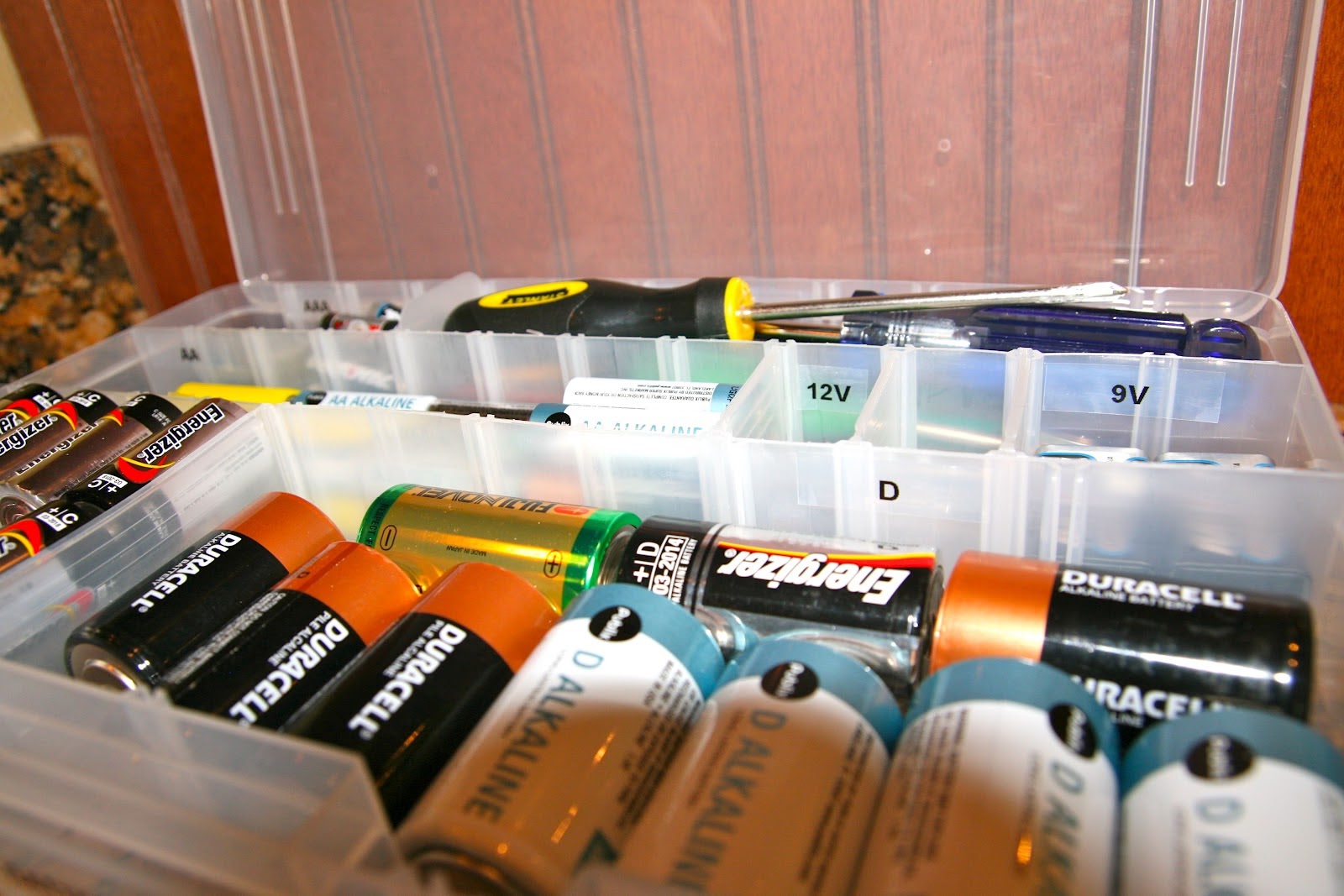

Articles
How To Store Batteries For Longer Life
Modified: January 9, 2024
Learn how to store batteries for longer life with our helpful articles. Discover tips and tricks to maximize battery lifespan and keep them in optimal condition.
(Many of the links in this article redirect to a specific reviewed product. Your purchase of these products through affiliate links helps to generate commission for Storables.com, at no extra cost. Learn more)
Introduction
Batteries are an essential component of our daily lives. From powering our smartphones and laptops to running our cars and storing energy for renewable sources, batteries play a crucial role in our modern society. However, one aspect that is often overlooked is the proper storage of batteries to ensure their longevity and performance.
When batteries are not stored correctly, they can lose their charge, leak, or even become damaged, resulting in reduced capacity and potential risks. Whether you have a collection of alkaline batteries for household gadgets or rechargeable batteries for your camera, it is important to understand how to store them properly to maximize their lifespan.
In this article, we will explore the importance of proper battery storage and provide valuable tips and recommendations for various battery types. By following these guidelines, you can ensure that your batteries remain in excellent condition for longer periods, saving you money and reducing unnecessary waste.
Key Takeaways:
- Proper storage of batteries is crucial for maintaining performance and longevity. Temperature and humidity control, specific storage recommendations for different battery types, and proper preparation are key to maximizing battery lifespan and reducing unnecessary waste.
- Long-term battery storage requires extra care, including maintaining the charge level, using suitable storage containers, and regular inspection. Following manufacturer guidelines and implementing these practices will ensure batteries remain in optimal condition for future use.
Read more: How To Store Batteries To Last Longer
Importance of Proper Battery Storage
Proper battery storage is essential to maintain the performance and longevity of batteries. When batteries are not stored correctly, they can deteriorate, lose their charge, or become damaged. This not only reduces their capacity to hold a charge but can also pose safety risks.
One common issue with improper battery storage is self-discharge. All batteries, regardless of type, have a natural self-discharge rate, meaning they gradually lose their charge over time, even when not in use. However, by implementing proper storage techniques, you can significantly slow down this process and extend the overall lifespan of your batteries.
Another crucial factor to consider is the risk of battery leakage. When batteries are exposed to extreme temperatures, humidity, or stored inappropriately, they can leak corrosive chemicals. Battery leakage can not only damage the device in which the batteries are stored but can also cause harm to the environment and pose a health risk to individuals handling them.
Proper battery storage is also important from an economic perspective. By taking care of your batteries and storing them correctly, you can maximize their lifespan, ultimately saving you money in the long run. Additionally, storing batteries properly helps reduce unnecessary waste and promotes sustainability by minimizing the need for frequent replacement.
Furthermore, it is crucial to note that different types of batteries require specific storage conditions to maintain their performance. Alkaline batteries, lithium-ion batteries, nickel-metal hydride (NiMH) batteries, and lead-acid batteries all have different requirements when it comes to storage temperature, humidity, and charging cycles. Understanding these differences and following the appropriate storage guidelines can greatly enhance the lifespan and performance of each battery type.
In the following sections, we will delve into the specific storage recommendations for different battery types, including alkaline batteries, lithium-ion batteries, NiMH batteries, and lead-acid batteries. By adhering to these guidelines, you can ensure that your batteries remain in optimal condition and deliver maximum performance when you need them the most.
Temperature and Humidity Considerations
Temperature and humidity are two critical factors to consider when it comes to storing batteries. Extreme temperatures and high humidity can have adverse effects on the performance and lifespan of batteries.
Firstly, it’s important to note that storing batteries in extremely hot or cold environments can cause them to lose their charge more quickly. High temperatures accelerate the chemical reactions within the battery, leading to faster self-discharge. On the other hand, extremely low temperatures can affect the battery’s ability to generate energy, resulting in reduced capacity.
To ensure optimal storage conditions, it is generally recommended to store batteries in a cool, dry place. Ideally, the temperature should be between 59°F (15°C) and 77°F (25°C). Avoid storing batteries in places with direct sunlight or near heat-emitting appliances such as radiators or ovens.
Humidity is another crucial factor to consider. High humidity levels can lead to moisture buildup inside the battery compartment, resulting in corrosion and potential damage to the battery. To prevent this, store batteries in a location with low humidity, preferably below 75%. Avoid storing batteries in areas prone to moisture, such as bathrooms or basements.
For long-term storage, it’s recommended to use airtight containers or packaging to protect batteries from exposure to moisture and humidity. You can use sealable plastic bags or specialized battery storage cases to keep batteries dry and protected.
By paying attention to temperature and humidity considerations, you can help preserve the performance and lifespan of your batteries. Creating a suitable storage environment will ensure that your batteries are ready for use whenever you need them, without any deterioration due to adverse conditions.
Battery Types and Storage Recommendations
Different battery types have different characteristics and requirements when it comes to storage. Let’s explore the specific storage recommendations for some commonly used battery types:
- Alkaline Batteries: Alkaline batteries are commonly used in household devices like remote controls, flashlights, and portable radios. To store alkaline batteries, it is best to remove them from devices when not in use. Store them at room temperature in a dry location. Avoid storing alkaline batteries in extremes of temperature or humidity. It is not necessary to store alkaline batteries in a refrigerator.
- Lithium-ion Batteries: Lithium-ion batteries are widely used in portable electronics like smartphones, laptops, and cameras. For lithium-ion batteries, store them in a cool, dry place with a temperature between 32°F (0°C) and 86°F (30°C). Avoid exposing them to high temperatures, as it can cause permanent damage. Ideally, charge lithium-ion batteries to around 50% capacity before long-term storage.
- Nickel-Metal Hydride (NiMH) Batteries: NiMH batteries are commonly used in devices like digital cameras, toys, and cordless phones. For storage, it is best to charge NiMH batteries to around 40% capacity before storing them. Store them in a cool, dry place with temperatures between 59°F (15°C) and 68°F (20°C). Avoid exposing NiMH batteries to high temperatures or extreme humidity.
- Lead-Acid Batteries: Lead-acid batteries are commonly used in automotive applications, as well as for backup power systems. It is important to keep lead-acid batteries in a fully charged state when in storage. Periodically check the charge level and recharge as needed. Store lead-acid batteries in a cool place with temperatures between 50°F (10°C) and 77°F (25°C). Ensure the storage area is well-ventilated to prevent the buildup of potentially explosive gases.
- Rechargeable Batteries: Rechargeable batteries, including NiMH, lithium-ion, and others, have specific storage requirements similar to their respective battery types. Always follow the storage guidelines provided by the manufacturer for rechargeable batteries to ensure the best performance and longevity.
By understanding the specific storage recommendations for different battery types, you can ensure that your batteries are stored in the most suitable conditions, maximizing their lifespan and performance.
Storing Alkaline Batteries
Alkaline batteries are commonly used in various household devices and gadgets. When not in use, it is important to store alkaline batteries properly to maintain their performance and prolong their lifespan. Here are some tips for storing alkaline batteries:
- Remove Batteries: When alkaline batteries are not in use, it is recommended to remove them from the devices. This prevents any potential leakage or corrosion that could occur over time.
- Dry Location: Find a cool, dry place to store alkaline batteries. Avoid storing them in areas with high humidity, such as bathrooms or basements, as this can lead to moisture buildup and damage the batteries.
- Temperature Considerations: Alkaline batteries should be stored at room temperature, ideally between 59°F (15°C) and 77°F (25°C). Avoid exposing them to extreme temperatures as it can affect their performance and reduce their capacity.
- Avoid Refrigeration: Contrary to popular belief, it is not necessary to store alkaline batteries in the refrigerator. Storing them at room temperature is sufficient.
- Organize and Protect: Consider using a battery storage case or an organizer to keep the alkaline batteries organized and protected from moisture or physical damage.
By following these storage recommendations, you can ensure that your alkaline batteries remain in good condition and are ready for use whenever you need them. Proper storage will also help prevent any leakage or damage, ensuring their safety and longevity.
Storing Lithium-Ion Batteries
Lithium-ion batteries are widely used in portable electronic devices such as smartphones, laptops, and cameras. Proper storage of lithium-ion batteries is crucial to maintain their performance and safety. Here are some recommendations for storing lithium-ion batteries:
- Charge Level: Before storing lithium-ion batteries, it is recommended to charge them to around 50% of their capacity. This helps prevent over-discharge during storage, which can lead to irreversible capacity loss.
- Cool, Dry Environment: Store lithium-ion batteries in a cool and dry place with a temperature ranging from 32°F (0°C) to 86°F (30°C). Avoid exposing them to high temperatures, as it can cause permanent damage to the battery’s capacity and performance.
- Avoid Extreme Conditions: Avoid storing lithium-ion batteries in extreme cold or hot temperatures. Extreme cold can cause the battery to become unresponsive, while extreme heat can lead to thermal runaway or even explosion.
- Proper Sealing: If storing loose lithium-ion batteries, make sure to cover the battery terminals with electrical tape or a plastic cap to prevent accidental short-circuits.
- Avoid Compression: Do not stack or compress lithium-ion batteries together during storage, as it can cause damage to the battery pack or compromise its safety.
Following these storage recommendations will help preserve the performance and safety of your lithium-ion batteries. By ensuring a proper charge level and storing them in suitable conditions, you can extend their lifespan and ensure they are ready for use when needed.
Store batteries in a cool, dry place at room temperature. Avoid extreme heat or cold, as it can reduce their lifespan. Keep them in their original packaging or in a battery organizer to prevent contact with metal objects.
Storing Nickel-Metal Hydride (NiMH) Batteries
Nickel-Metal Hydride (NiMH) batteries are commonly used in devices such as digital cameras, toys, and cordless phones. Proper storage of NiMH batteries is essential to maintain their performance and longevity. Here are some recommendations for storing NiMH batteries:
- Charge Level: Before storing NiMH batteries, it is best to charge them to around 40% of their capacity. This helps prevent over-discharge during storage, which can lead to capacity loss over time.
- Cool, Dry Environment: Store NiMH batteries in a cool and dry place with temperatures ranging from 59°F (15°C) to 68°F (20°C). Avoid exposing them to high temperatures, as it can reduce their performance and overall capacity.
- Avoid Extreme Conditions: Prevent storing NiMH batteries in extreme cold or hot temperatures, as it can negatively impact their performance and lifespan. Extreme cold can reduce the battery’s capacity, while extreme heat can cause leakage or even rupture.
- Proper Sealing: If storing loose NiMH batteries, cover the battery terminals with electrical tape or use battery caps to prevent accidental short-circuits.
- Protect from Physical Damage: Handle NiMH batteries with care and avoid dropping or exposing them to excessive vibration, as it can damage the internal structure and integrity of the battery.
By following these storage recommendations, you can ensure that your NiMH batteries remain in good condition and are ready for use when needed. Proper storage will help maintain their performance, prevent leakage, and prolong their overall lifespan.
Storing Lead-Acid Batteries
Lead-acid batteries are commonly used in automotive applications and backup power systems. Proper storage of lead-acid batteries is essential to maintain their performance and ensure their longevity. Here are some recommendations for storing lead-acid batteries:
- Charge Level: Ensure that lead-acid batteries are fully charged before storing them. This helps prevent sulfate build-up and sulfation, which can negatively impact the performance and lifespan of the battery.
- Cool Environment: Store lead-acid batteries in a cool, well-ventilated area with temperatures ranging from 50°F (10°C) to 77°F (25°C). Avoid exposing them to extreme heat or cold, as it can affect the battery’s capacity and overall performance.
- Regular Inspection: Periodically check the charge level of stored lead-acid batteries and recharge them as needed. This ensures that the batteries remain in a fully charged state and ready for use when required.
- Ventilation: It is crucial to store lead-acid batteries in a well-ventilated area to prevent the buildup of potentially explosive gases that lead-acid batteries can emit during charging or discharging. Avoid storing them in enclosed spaces or areas without proper airflow.
- Avoid Tipping: Handle lead-acid batteries with care to avoid tipping or dropping them, as it can cause leakage or damage to the battery casing.
By adhering to these storage recommendations, you can ensure that your lead-acid batteries remain in optimal condition and maintain their performance over extended periods. Regular inspection and proper ventilation will contribute to the longevity and reliability of the batteries, enabling them to deliver power effectively when needed.
Storing Rechargeable Batteries
Rechargeable batteries, such as those using nickel-metal hydride (NiMH), lithium-ion, or other technologies, require proper storage to maintain their performance and extend their lifespan. Here are some recommendations for storing rechargeable batteries:
- Charge Level: Before storing rechargeable batteries, it is ideal to charge them to around 40-50% of their capacity. This helps prevent over-discharge during storage, which can lead to capacity loss or damage to the battery.
- Cool, Dry Environment: Store rechargeable batteries in a cool and dry place with a temperature ranging from 59°F (15°C) to 77°F (25°C). Avoid exposing them to high temperatures as it can reduce their performance and overall capacity. Also, ensure that the storage area is not overly humid, as excessive moisture can damage the battery.
- Separate Storage: Avoid storing rechargeable batteries together with metal objects, as it can increase the risk of short-circuiting. If possible, keep individual batteries in separate compartments or use dedicated battery storage cases.
- Avoid Physical Damage: Handle rechargeable batteries with care to prevent physical damage. Avoid dropping them or subjecting them to excessive pressure or vibration, as it can affect their performance and integrity.
- Regular Usage: If you plan to store rechargeable batteries for an extended period, it is recommended to use them periodically. Every few months, recharge and discharge the batteries to ensure they maintain their capacity and prevent stagnation.
By following these storage recommendations, you can ensure that your rechargeable batteries remain in optimal condition for future use. Proper storage will help maintain their performance, prevent damage, and extend their overall lifespan, saving you money and reducing unnecessary waste.
Read more: How To Store Strawberries For Longer
Preparing Batteries for Storage
Before storing batteries, it is important to take a few steps to properly prepare them. These preparations will help preserve the batteries’ performance and ensure they are ready for use when needed. Here are some important steps to follow when preparing batteries for storage:
- Clean Batteries: Before storing batteries, make sure they are clean and free from any dirt, dust, or residue. Use a clean cloth or a mild solution of water and vinegar to wipe the battery contacts and remove any contaminants that could potentially affect the battery’s performance.
- Remove Batteries from Devices: If batteries are not in use, it is recommended to remove them from devices. Leaving batteries in devices for long periods, especially those that are rarely used, can lead to corrosion, leakage, or damage. Take the time to safely remove the batteries and keep them separate.
- Check Charge Level: Before storing rechargeable batteries, check their remaining charge level. If the batteries are not fully charged, it is best to recharge them or bring them to around 40-50% of their capacity. This helps prevent over-discharge during storage that could negatively impact their overall performance.
- Inspect for Damage: Before storing batteries, inspect them for any signs of damage or leakage. If you notice any damage or leakage, it is best to properly dispose of the batteries and avoid storing them. Damaged batteries can pose safety risks and should be handled with care and disposed of following local regulations.
- Store in a Suitable Container: For loose batteries, consider using an airtight plastic bag, a specialized battery storage case, or even their original packaging for storage. These containers will help protect the batteries from exposure to moisture, humidity, and other potential sources of damage.
By following these steps and properly preparing batteries for storage, you can ensure that they remain in good condition and ready for use in the future. Proper preparation will help maintain their performance, prevent damage, and extend their overall lifespan, allowing you to get the most out of your batteries.
Tips for Long-Term Battery Storage
Long-term battery storage requires extra care and attention to ensure that the batteries remain in optimal condition. Whether you are storing alkaline, lithium-ion, NiMH, or other types of batteries, here are some valuable tips to follow for long-term storage:
- Charge Level: For rechargeable batteries, it is best to store them at around 40-50% of their capacity. This helps prevent over-discharge during storage, which can lead to capacity loss or damage. Avoid storing rechargeable batteries in a fully charged or completely discharged state.
- Clean Batteries: Before storing batteries, ensure they are clean and free of any dirt or residue. Clean the battery contacts using a cloth or a mild solution of water and vinegar to remove any contaminants that could affect performance.
- Suitable Storage Containers: Use airtight containers, sealable plastic bags, or specialized battery storage cases to keep batteries protected from moisture, humidity, and other sources of damage. This will help preserve their performance and prevent potential leakage.
- Cool, Dry Environment: Store batteries in a cool and dry place with temperatures within the recommended range for each specific battery type. Avoid exposing batteries to extreme temperatures or high humidity, as it can adversely affect their performance and lifespan.
- Regular Inspection: Periodically check on stored batteries to ensure they are still in good condition. Look for any signs of leakage, corrosion, or damage. If any issues are detected, handle the batteries with care and dispose of them properly.
- Recharge and Rotate: For rechargeable batteries, it is beneficial to recharge and use them periodically, especially if they will be stored for an extended period. This helps maintain their capacity and prevents them from sitting idle for too long.
- Follow Manufacturer Guidelines: Always refer to the manufacturer’s instructions and guidelines for specific storage recommendations. Different battery types may have unique requirements, so it’s important to follow their guidelines for optimal storage conditions.
By implementing these tips for long-term battery storage, you can ensure that your batteries remain in good condition and are ready for use when needed. Proper storage practices will help maximize their lifespan, maintain performance, and reduce the risk of leakage or damage.
Conclusion
Proper battery storage is essential to maintain the performance, longevity, and safety of batteries. Whether you are storing alkaline, lithium-ion, NiMH, or other types of batteries, following the appropriate storage recommendations is important to ensure their optimal condition and readiness for use when needed.
Temperature and humidity control are critical factors when storing batteries. Aim to store batteries in a cool, dry place with temperatures within the recommended range for each specific battery type. Extreme temperatures and high humidity can have detrimental effects on battery performance and can even lead to leakage or damage.
Different battery types require specific storage considerations. Alkaline batteries should be stored at room temperature, while lithium-ion batteries require cool, dry environments. NiMH batteries benefit from being stored at around 40% of their capacity, and lead-acid batteries should be stored in a fully charged state and a well-ventilated area.
Proper preparation is key before storing batteries. Clean the battery contacts, remove batteries from devices if not in use, and check their charge levels. Use suitable containers, such as airtight bags or specialized battery storage cases, to protect batteries from moisture and physical damage.
Remember to periodically inspect stored batteries for any signs of damage or leakage and recharge or rotate batteries as necessary. Following the manufacturer’s guidelines for storage is also crucial, as different battery brands and models may have specific recommendations.
By implementing these practices, you can prolong the lifespan, maintain the performance, and ensure the safety of your batteries. This not only saves you money but also reduces unnecessary waste and promotes sustainability.
Take the time to properly store your batteries, and they will be ready to power your devices whenever you need them, providing reliable performance and peace of mind.
Frequently Asked Questions about How To Store Batteries For Longer Life
Was this page helpful?
At Storables.com, we guarantee accurate and reliable information. Our content, validated by Expert Board Contributors, is crafted following stringent Editorial Policies. We're committed to providing you with well-researched, expert-backed insights for all your informational needs.














0 thoughts on “How To Store Batteries For Longer Life”